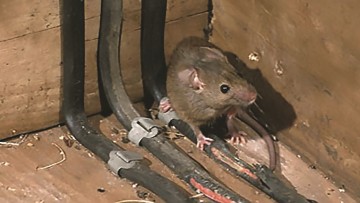Rodents [Rodentia]
Rodents pose the risk of disease transmission, economic hardship, significant damage to property and infrastructure, and a potentially catastrophic dent to an organisation’s reputation. BASF’s rodent control solutions are based on a thorough understanding of rodent biology and behaviour.


Damages caused / challenges

Health hazard
Rodents carry a range of infectious diseases that they can transmit to humans, pets and livestock. They spread more than 200 human pathogens via their feet, fur, urine, saliva, and blood as they scurry around sources of food, putting those within the vicinity of an infestation at risk of food poisoning or more serious conditions.
Economic impact
A single rat is capable of consuming and contaminating 100 kg of stored grain and feed in one year. Multiply that by the number of rats infesting a farm and the scale of the impact on operating costs can be staggering.
In urban environments, rodents also consume and contaminate a wide range of food found, for example, in bars, cafés and restaurants, as well as in homes, hospitals and schools.
Rodent damage can also result in downtime. Premises may have to close temporarily following a failed hygiene audit for instance, or equipment may be damaged, halting the production process. In either scenario, downtime means financial loss.

Structural damage
The destructive behaviour of rodents adds to the cost of an infestation. Because their incisor teeth grow constantly, rodents need to gnaw incessantly to wear them down. Wood, plastic and even metal can all come under the attack of those sharp incisors. Rats and mice pose a significant fire risk, when they strip electrical cables of their insulation. They are also capable of causing floods by puncturing water pipes of their insulation.
Reputation damage
Evidence of rodent infestation on the premises of any business is bad news. The reputation damage associated with the presence of mice and rats can be very difficult to overcome. These pests typically generate disgust in a commercial setting , as they are synonymous with filth and disease.
Profile
| Brown rat | Black rat | House mouse | |
|---|---|---|---|
| Scientific name | Rattus norvegicus | Rattus rattus | Mus musculus |
| How to recognise these rodents | Thick-set build Measures 22cm, plus 17cm tail Weighs 300g Brown/grey fur on the back, lighter belly Blunt snout | Slender build and agile Measures 20cm, plus 22cm tail Weighs 200g Black to brown fur on the back, lighter belly Very sharp snout | Slender build Measures 9cm, plus 9cm tail Weighs 15g Brown/grey fur on the back, lighter belly Sharp snout |
| How to recognise their droppings | spindle shape (20mm) | sausage shape (15mm) | spindle shape (6mm) |
| Reproduction | 3 to 12 litters of between six and eight young in a year | 3 to 12 litters of between six and eight young in a year | 5 to 10 litters with an average of six to eight young in a year |
| Diet | Omnivorous | Omnivorous | Omnivorous |
| Environment | Cosmopolitan: farms, refuse tips, sewers, hedgerows, farm houses, domestic environment | Cosmopolitan: temperate climates indoors around ships – now inland | Cosmopolitan |
| Behaviour | Excellent swimmers, good climbers Can fit into 15 mm gap Usually burrows Mainly outdoors and travel indoors | Excellent climber Rarely burrows Usually indoors | Sometimes burrows Good climbers, swimmers, jumpers Can fit into 5 mm gap Usually indoors |
How to control
Understanding rodent biology and behaviour
Rodents have a very developed sense of smell as well as excellent hearing. They are capable of communicating effectively with one another, using pheromones and smells. In addition, they are notoriously successful breeders.
A good understanding of rodent biology and behaviour is key to designing and implementing an effective control programme. BASF offers rodenticide bait solutions with proven efficacy to be used as part of an integrated pest management (IPM) programme. This consists of
- preventative measures like the removal of food sources and rodent proofing to minimise rodent access to food or feed sources,
- non-chemical control measures like mechanical traps
- and baiting using rodenticide baits to control a rodent infestation.
Removing food sources
Removing food sources is important to the success of a baiting programme. Storing food in airtight containers and closing bins securely with a properly fitting lid are just two simple measures that can be taken to prevent access to food or waste.
Rodent proofing
Rats only need 15 mm to gain entry into a building and mice can do it with just 5 mm. Here are some of the measures that can be taken to proof buildings and premises against rodents:
- Seal gaps in walls, under doors, in storage areas etc.
- Check drain covers
- Repair any roof damage.
Trapping
Traps are an important part of an IPM strategy, and are available in different shapes, sizes, and types. They can also be used to help to identify the rodent species and for quick knock down of infestations or problem rats and mice. Please always refer to user guidelines for the use and checking of traps
Rodenticides
BASF’s tried and tested rodenticide baiting solutions are research-led products with proven efficacy. The innovative, high-performance baits have been designed to be highly palatable, easy-to-use and effective in a range of environments.

